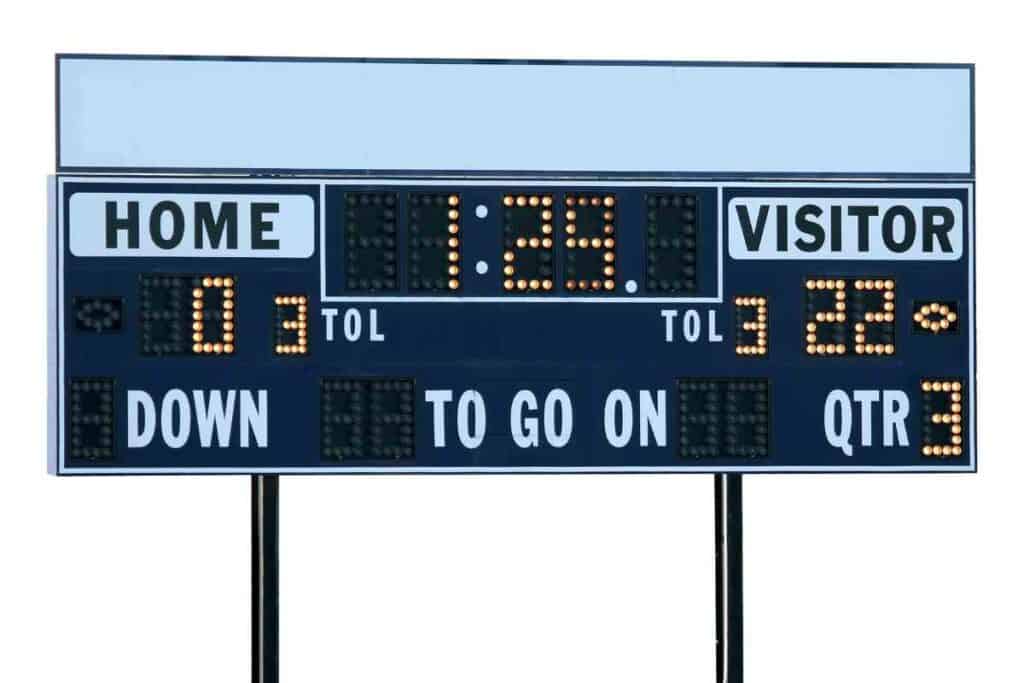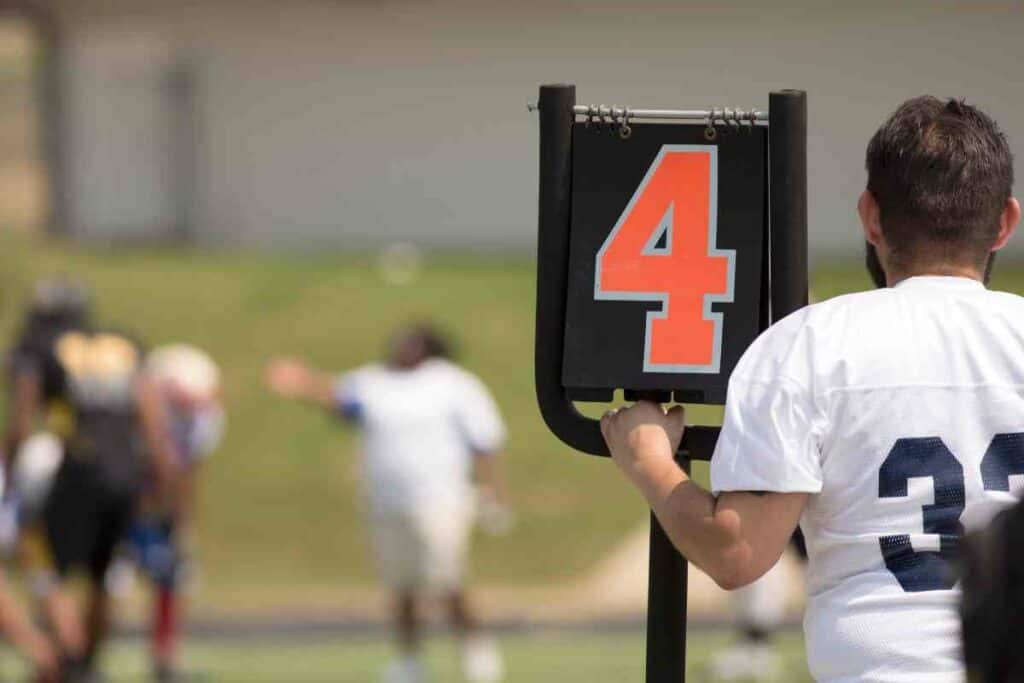How Long Do College Football Quarters Last? Explained.
College football holds a special place in the hearts of millions of fans across the United States, captivating audiences with its thrilling competitions year after year. While the game itself is an adrenaline rush, it is essential to grasp the rules and regulations that govern its play. Among these vital aspects is the duration of each quarter, which can significantly sway the game’s outcome.

How long are college football quarters?
In college football, games are divided into four quarters, with each quarter lasting 15 minutes. This standard format means that a typical college football game spans 60 minutes, excluding any overtime periods. However, it’s important to note that the clock stops after specific plays, such as incomplete passes or players going out of bounds, which can extend the overall game time.
To gain a deeper understanding of how the length of college football quarters impacts the game, consider the following breakdown:
| Quarter | Length | Total Time |
|---|---|---|
| 1 | 15 min | 15 min |
| 2 | 15 min | 30 min |
| 3 | 15 min | 45 min |
| 4 | 15 min | 60 min |
Coaches must skillfully manage the clock, making strategic decisions regarding timeouts and player substitutions to give their team the best shot at victory.
Key Takeaways:
- College football games consist of four quarters, each lasting 15 minutes, totaling 60 minutes excluding overtime.
- Coaches strategically manage the clock through running plays, quick passes, and well-timed timeouts.
- Halftime provides an opportunity for teams to regroup, make adjustments, and rest, with a duration of 20 minutes in college football.
- Effective time management and adaptability are key factors in achieving victory in college football.
Overview of College Football Quarters
Understanding the structure of college football quarters is essential to fully grasp the dynamics of the game. In this section, we will provide an overview of college football quarters, including their duration, the number of quarters in a game, and the length of halftime.
Duration of College Football Quarters
Each quarter in college football has a duration of 15 minutes. The clock starts running as soon as the ball is snapped, and it continues to run until the play is over.
However, there are instances when the clock stops, such as when a player steps out of bounds or when there is an incomplete pass. Consequently, the actual playing time of each quarter is slightly shorter than the designated 15 minutes.
That said, there are so many other stoppages that college football games can end up long, sometimes over 3 hours.
Number of Quarters in a College Football Game
A college football game consists of four quarters. This aligns with professional football, where games are also divided into four quarters.
However, it differs from high school football, which features four 12-minute quarters. In college football, the four quarters are played consecutively, with a brief break between each quarter.
Length of Halftime in College Football
Halftime in college football extends for 20 minutes. This duration is longer compared to halftime in professional football, which lasts for 12 minutes.
During halftime, the players retreat to their locker rooms to rest, strategize, and recharge.
Additionally, the halftime show, often featuring captivating performances by marching bands and other entertainers, adds to college football’s vibrant atmosphere and spectacle.
To summarize, college football quarters last for 15 minutes each, with four quarters in a game. Halftime lasts for 20 minutes, providing players with a chance to rest and recover before returning to the field. The game clock runs continuously, except under certain circumstances, and the actual playing time of each quarter is slightly shorter than 15 minutes.

Comparison with Other Football Leagues
Football is played in various leagues, each with its own set of rules and regulations. In this section, we will compare the duration of college football quarters with other football leagues, namely the NFL and high school football.
College Football vs. NFL Football
In terms of game length, college football and NFL football are on par. Both leagues have four quarters, each lasting 15 minutes, resulting in a total game time of 60 minutes.
However, there are differences in how the clock is managed. In college football, the clock stops after first downs, out-of-bounds plays, and changes of possession, which can extend the overall game duration. In the NFL, the clock stops in specific situations such as incomplete passes, penalties, and timeouts.
College Football vs. High School Football
When comparing college football to high school football, there are notable differences in quarter length.
High school football games consist of four quarters, each lasting 12 minutes, resulting in a total game time of 48 minutes, shorter than both college and NFL games.
Additionally, halftime in high school football is 10 minutes, while college football has a 15-minute halftime duration.
High school football also allows three timeouts per half, whereas college football permits three timeouts per half and an additional timeout per team per game.
Understanding the variations in quarter length and other game elements across different football leagues enhances appreciation for the uniqueness of each level of play.
| League | Quarter Length | Halftime Length | Total Game Time |
|---|---|---|---|
| College Football | 15 minutes | 15 minutes | 60 minutes |
| NFL | 15 minutes | 12 minutes | 60 minutes |
| High School Football | 12 minutes | 10 minutes | 48 minutes |
Strategies and Tactics for Managing College Football Quarters
In the fast-paced world of college football, the game is divided into four quarters, each lasting 15 minutes.
With the clock ticking away, teams must employ effective strategies to maximize their limited time, utilize halftime strategically, and adapt their game plan in the second half.

Managing the Clock in College Football
Clock management becomes paramount, particularly in the fourth quarter when the outcome hangs in the balance. Teams employ various tactics to control the clock effectively, including:
- Running the ball: Running plays keep the clock running, reducing the number of possessions for the opposing team.
- Quick passes: Short, efficient passes help teams move down the field while keeping the clock ticking.
- Strategic timeouts: Teams can halt the clock by using timeouts, but since they are limited to three per half, careful consideration is crucial in their usage.
Leveraging Halftime
Halftime plays a crucial role in the game, providing teams with an opportunity to regroup, make adjustments, and recharge.
Coaches utilize this time to review game footage, discuss strategy with the team, and implement necessary changes to their game plan. Players can take advantage of this break to rest, hydrate, and receive any required medical attention.
Adjusting Strategies in the Second Half
At halftime, teams often make crucial adjustments to counter their opponent’s strengths and weaknesses.
For instance, if a team is struggling to defend against the run, they might opt for a more run-heavy offensive approach in the second half. Additionally, teams may modify their personnel or alter their play-calling to keep the opposing defense off-balance and gain an edge.
In the bigger picture, college football games are strategic battles where teams must utilize their time wisely, adapt their tactics, and showcase their skills on both offense and defense.
Two-point conversions also hold significance, requiring teams to decide when to attempt them based on the score and time remaining.
A well-executed strategy can be the decisive factor in a closely contested game, demanding teams to remain flexible and adjust throughout their quest for victory.
| Strategy | Description |
|---|---|
| Running the ball | Keeps the clock running and limits the number of possessions the opposing team has |
| Quick passes | Moves the ball down the field while keeping the clock running |
| Calling timeouts | Stops the clock, but teams only have three per half |
| Halftime | Time for coaches to review game film, discuss strategy, and make necessary changes to their game plan |
| Second-half adjustments | Teams make changes to their personnel or switch up their play-calling to keep the opposing defense off-balance |
Unusual Circumstances Impacting College Football Quarters
In the realm of college football, games are typically divided into four quarters, each spanning 15 minutes. However, certain uncommon circumstances can arise during a game, potentially altering the duration or outcome of a quarter.
Overtime: When Regulation Isn’t Enough
If the score remains tied at the conclusion of regular playing time, the game transitions into overtime.
In college football, each team receives possession of the ball at the opponent’s 25-yard line, with four downs to score. The team that accumulates the most points during the overtime period emerges as the victor.
Game Ending in a Tie
In college football, a tie can only occur if both teams remain equal after the overtime period. Although rare, as overtime periods typically produce a winner, if a game concludes with a tie, it is officially recorded as such.
Unplayable Field Conditions
In the event that the playing field becomes muddy or otherwise unsuitable for play, officials may institute a running clock.
This means that the clock continues to run even during timeouts or after an incomplete pass, minimizing potential delays and prioritizing player safety.
In extreme cases, a game might be postponed or canceled altogether. Such decisions are typically made by officials in consultation with the coaches and athletic directors of the involved teams, taking into account factors like player well-being and the feasibility of maintaining the game’s integrity.
While college football quarters are typically set at 15 minutes, unforeseen circumstances like overtime, ties, or unplayable field conditions can impact the length or outcome of a quarter. Officials possess various mechanisms to ensure player safety and uphold the game’s principles.
Conclusion
College football quarters last for 15 minutes each, with four quarters in a game. Coaches strategically manage the clock through running plays, quick passes, and well-timed timeouts.
Halftime provides an opportunity for teams to regroup, make adjustments, and rest, while the second half often sees teams making strategic changes to counter their opponent’s strengths.
Unusual circumstances such as overtime, ties, or unplayable field conditions can affect the length or outcome of a quarter.
In overtime, teams have four downs to score from the opponent’s 25-yard line, with the team accumulating the most points winning the game.
Ties are rare in college football, but if a game ends in a tie after overtime, it is officially recorded as such.
When the field becomes unplayable, officials may institute a running clock to maintain player safety and minimize delays.
Ultimately, college football is a strategic game where effective time management and adaptability play crucial roles in achieving victory.
